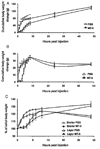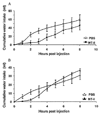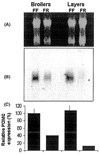The melanocortin circuit in obese and lean strains of chicks
- PMID: 16899585
- PMCID: PMC2730167
- DOI: 10.1677/joe.1.06783
The melanocortin circuit in obese and lean strains of chicks
Abstract
Agonists of membranal melanocortin 3 and 4 receptors (MC3/4Rs) are known to take part in the complex control mechanism of energy balance. In this study, we compared the physiological response to an exogenous MC3/4R agonist and the hypothalamic expression of proopic melanocortin (POMC) gene, encoding few MC3/4R ligands, between broiler and layer chicken strains. These strains, representing the two most prominent commercial strains of chickens grown for meat (broilers) and egg production (layers), differ in their food intake, fat accumulation, and reproductive performance and, therefore, form a good model of obese and lean phenotypes, respectively. A single i.v. injection of the synthetic peptide melanotan-II (MT-II; 1 mg/kg body weight) into the wing vein of feed-restricted birds led to attenuation of food intake upon exposure to feeding ad libitum in both broiler and layer chickens. A study of the POMC mRNA encoding the two prominent natural MC3/4R agonists, alpha-MSH and ACTH, also revealed a general similarity between the strains. Under feeding conditions ad libitum, POMC mRNA levels were highly similar in chicks of both strains and this level was significantly reduced upon feed restriction. However, POMC mRNA down-regulation upon feed restriction was more pronounced in layers than in broilers. These results suggest: (i) a role for MC3/4R agonists in the control of appetite; (ii) that the physiological differences between broilers and layers are not related to unresponsiveness of broiler chickens to the satiety signal of MC3/4R ligands. Therefore, these findings suggest that artificial activation of this circuit in broiler chicks could help to accommodate with their agricultural shortcomings of overeating, fattening, and impaired reproduction.
Figures





Similar articles
-
A comparative study of the central effects of melanocortin peptides on food intake in broiler and layer chicks.Peptides. 2012 Sep;37(1):13-7. doi: 10.1016/j.peptides.2012.06.015. Epub 2012 Jul 1. Peptides. 2012. PMID: 22760063
-
Food intake reductions and increases in energetic responses by hindbrain leptin and melanotan II are enhanced in mice with POMC-specific PTP1B deficiency.Am J Physiol Endocrinol Metab. 2012 Sep 1;303(5):E644-51. doi: 10.1152/ajpendo.00009.2012. Epub 2012 Jul 3. Am J Physiol Endocrinol Metab. 2012. PMID: 22761160 Free PMC article.
-
In vivo evidence for inverse agonism of Agouti-related peptide in the central nervous system of proopiomelanocortin-deficient mice.Diabetes. 2008 Jan;57(1):86-94. doi: 10.2337/db07-0733. Epub 2007 Oct 1. Diabetes. 2008. PMID: 17909095
-
Pro-opiomelanocortin processing in the hypothalamus: impact on melanocortin signalling and obesity.J Endocrinol. 2002 Mar;172(3):411-21. doi: 10.1677/joe.0.1720411. J Endocrinol. 2002. PMID: 11874690 Review.
-
The melanocortin pathway and control of appetite-progress and therapeutic implications.J Endocrinol. 2019 Apr 1;241(1):R1-R33. doi: 10.1530/JOE-18-0596. J Endocrinol. 2019. PMID: 30812013 Free PMC article. Review.
Cited by
-
Gene transfer to chicks using lentiviral vectors administered via the embryonic chorioallantoic membrane.PLoS One. 2012;7(5):e36531. doi: 10.1371/journal.pone.0036531. Epub 2012 May 11. PLoS One. 2012. PMID: 22606269 Free PMC article.
-
Wet Feeding Promotes Growth without Affecting Hypothalamic Peptide Gene Expression in Growing Broiler Chicks.J Poult Sci. 2025 Feb 7;62:2025008. doi: 10.2141/jpsa.2025008. eCollection 2025. J Poult Sci. 2025. PMID: 39925947 Free PMC article.
-
Should I Lay or Should I Grow: Photoperiodic Versus Metabolic Cues in Chickens.Front Physiol. 2020 Jun 26;11:707. doi: 10.3389/fphys.2020.00707. eCollection 2020. Front Physiol. 2020. PMID: 32670092 Free PMC article. Review.
-
Regulation of Agouti-Related Protein and Pro-Opiomelanocortin Gene Expression in the Avian Arcuate Nucleus.Front Endocrinol (Lausanne). 2017 Apr 13;8:75. doi: 10.3389/fendo.2017.00075. eCollection 2017. Front Endocrinol (Lausanne). 2017. PMID: 28450851 Free PMC article. Review.
-
The physiological and neuroendocrine correlates of hunger in the Red Junglefowl (Gallus gallus).Sci Rep. 2017 Dec 21;7(1):17984. doi: 10.1038/s41598-017-17922-w. Sci Rep. 2017. PMID: 29269733 Free PMC article.
References
-
- Ahima RS, Flicr JS. Adiposc tissue as an endocrine organ. Trends in Endocrinology and Metabolism. 2000;11:327–332. - PubMed
-
- Al-Obeidi F, Hruby VJ, Castrucci AM, Hadley ME. Design of potent linear alpha-melanotropin 4–10 analogues modified in positions 5 and 10. Journal of Medicinal Chemistry. 1989a;32:174–179. - PubMed
-
- Al-Obeidi F, Castrucci AM, Hadley ME, Hruby VJ. Potent and prolonged acting cyclic lactam analogues of alpha-melanotropin: design based on molecular dynamics. Journal of Medicinal Chemistry. 1989b;32:2555–2561. - PubMed
-
- Azzara AV, Sokolnicki JP, Schwartz GJ. Central melanocortin receptor agonist reduces spontaneous and scheduled meal size but does not augment duodenal preload-induced feeding inhibition. Physiology and Behavior. 2002;77:411–416. - PubMed
-
- Bellinger L, Cepeda-Benito A, Bullard RL, Wellman PJ. Effect of i.c.v. infusion of the alpha-MSH agonist MTII on meal patterns in male rats following nicotine withdrawal. Life Sciences. 2003;73:1861–1872. - PubMed
Publication types
MeSH terms
Substances
Grants and funding
LinkOut - more resources
Full Text Sources
Medical
Miscellaneous

